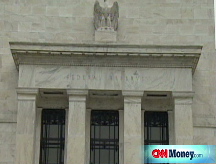The Fed hangs on to its last bullet
The central bank has taken many steps to try and unfreeze the credit markets, but there is one more thing it could do: buy Treasurys. That appears to be next.


 |
| Long-term bond rates have spiked higher recently....but they are still relatively low by historical standards. |
NEW YORK (CNNMoney.com) -- Should the Federal Reserve start buying up long-term Treasury bonds?
The bond market was disappointed Wednesday when the Fed announced that it was leaving interest rates near zero. There was a hope among some fixed-income investors and economists that the central bank would also announce a program to purchase U.S. Treasurys.
Instead, the Fed merely hinted that it might do so in the future, "if evolving circumstances indicate that such transactions would be particularly effective in improving conditions in private credit markets."
The rationale for buying Treasurys is fairly clear-cut. The Fed has made many efforts to try and defrost the credit markets ... so far to little avail.
But if the Fed buys U.S. bonds, that would drive up their price and push down their yield. (Prices and yields move in opposite directions.) By doing that, the Fed could help get credit flowing in the economy once again since rates tied to long-term Treasurys would also fall.
And one member of the central bank's interest-rate setting Federal Open Market Committee does think the Fed should be buying Treasurys now.
According to Wednesday's statement, Richmond Federal Reserve Bank president Jeffrey Lacker voted in favor of buying Treasurys instead of using "targeted credit programs" like the Fed's plan to buy mortgage-backed securities.
Still, would the purchase of Treasurys really be a good idea? After all, it's not as if rates are high right now. Even with a big drop in prices and corresponding spike in yields Tuesday, the U.S. 10-Year Treasury still has a relatively low yield of about 2.7%. The 30-Year's yield is below 3.5%
Ray Stone, an economist with Stone & McCarthy, a Princeton-based fixed income and economic research firm, said he thinks the Fed would probably prefer to see if existing programs to try and free up credit work before it starts buying Treasurys.
In addition to the Fed's purchases of mortgage-backed securities, the central bank will soon implement the so-called Term Asset-Backed Securities Loan Facility for credit cards, student loans and small business loans.
"The Fed is trying to get private sector borrowing costs lower. There are a lot of things in the pipeline," Stone said.
What's more, it's not entirely clear that buying Treasurys would really accomplish that much. That's because there are two aspects to the lending equation.
Sure, driving down rates may make people more willing to apply for credit to buy homes and cars or to start a business. But that doesn't mean banks will suddenly be willing to extend credit again.
"You can lower rates but lending standards have gone up dramatically. Just because you apply for a mortgage doesn't mean you are going to get approved," said Matthew Smith, chief investment officer with Smith Affiliated Capital, a wealth management firm in New York with $2.2 billion in assets.
Smith argues that as long as banks are stuck with toxic assets on their balance sheets, no amount of credit easing will convince banks to lend more freely.
"The idea is to try and force people to invest and borrow. But it's not happening because what the Fed hasn't done is take out the illiquid securities in these banks," he said.
Steve Van Order, chief fixed income strategist with Calvert Funds, a Bethesda, Maryland-based money manager with about $10 billion in fixed income assets, agreed.
Van Order pointed out that the money supply has been growing since the credit markets seized up in the wake of Lehman Brother's collapse in September but that banks still aren't lending.
With that in mind, Van Order said he thinks the statement about being prepared to buy Treasurys is more jawboning by the Fed than anything else.
Even though long-term rates are still on the low side, some are concerned about the rise in yields over the past few months and that rates could head even higher. The yield on the 10-Year, for example, dipped to nearly 2% in mid-December.
"This is a message to the bond market that if people are thinking of selling Treasurys to push rates higher, the Fed could show up on the buy side to push against that. They are reminding us that they are out there," Van Order said.
When all is said and done, the Fed is probably reluctant to buy Treasurys unless absolutely necessary because it knows that by doing so, it increases the chances of inflation rearing its ugly head when there is an eventual recovery.
Still, Stone said it's probably a risk the Fed is willing to take right now since the possibility of deflation, or falling prices, is a much more pervasive short-term concern.
In addition, Van Order and Smith both said the Fed probably doesn't need to worry too much about the possibility of scaring off foreign investors or weakening the dollar by purchasing Treasurys and driving down rates. That's because the entire world, and not just the U.S. is under severe economic stress.
"As long as the world goes down together, the U.S. dollar and Treasurys still look liquid and safe," Van Order said.
And for that reason, one expert said it's probably inevitable that the Fed will eventually start buying Treasurys.
"It's in the cards, I think it's just a matter of time," said John Derrick, director of research with U.S. Global Investors, a San Antonio-based money manager with $2.5 billion in assets. "There have been concerns about the Fed buying lower-quality assets. If they go the Treasury route, that would be a better use of the Fed's balance sheet because the assets are not as risky." ![]()


